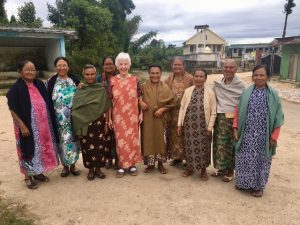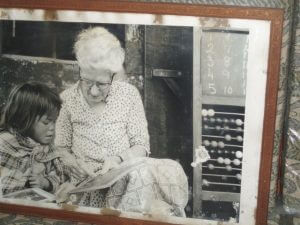by Barb Clagett
New Lives, New Possibilities Because of Kong Barr’s Educational Programs

Kong Barr passionately disassociated herself from a “missionary” mindset, not taking on “the leadership of the Khasi Unitarian Movement, but by improving educational opportunities to enable them to get educated leaders amongst themselves, and so strengthen the self-reliance which had been one of the outstanding qualities of their founder, Hajom Kissor Singh…” (A Dream Come True: The Story of Kharang by Margaret Barr, p. 37)
Thus began her immersion in the world of the Khasis. During the next 20 years, Kong Barr took on various teaching projects in larger towns in the Khasi Hills, such as Shillong and Jowai, and learned to speak, read, and write the Khasi language. With encouragement from Hajom Kissor Singh’s son, Ekman, she then settled in the late 40’s in the area of Kharang, about halfway between Shillong and Jowai – fulfilling Gandhi’s suggestion. There, in the early 50’s, she started her own school based on principles that honored the child and included not only traditional subjects like English, math, geography, history, hygiene, and science, but also learning crafts like knitting and weaving, and skills such as farm work, keeping weather records, house-keeping, cooking, and even star-gazing. Here she was again influenced by Gandhi, whose education program had inspired her. A British inspector, after visiting her school, reported, “I could never have believed that Khasi children could be so alert and so happy.”
Fast forward: In 2011 I took my first trip to the Khasi Hills to meet our partner church members in the village of Kharang, the very area where Kong Barr lived and had had her school. A high school bearing her name was in full operation nearby. It was the time of the Anniversary of the founding of Unitarianism in the Khasi Hills, and I was staying with a wonderful family. One of my first conversations was with my hostess who, it turned out, had been one of Kong Barr’s very first students! I had somehow not expected to meet any of her students, but here she was, a well-known midwife in the community, thanks to the educational opportunities that Kong Barr gave her! Later I became friends with others in the Kharang area who had also been her students. The germ of an idea started to grow: why not interview as many of her former students as possible and find out what kind of experiences they had had with her? What made a difference in their lives?

What the interviewees all noticed right away was how well Kong Barr spoke Khasi. When she led Unitarian services, she spoke in Khasi. She even wrote a primer in Khasi on the history, principles and historical events and people in Unitarian history (from Servetus through England and the US) to share with the Khasi people. Those interviewed also reported that she loved singing nursery rhymes and songs like “Swing Low, Sweet Chariot” with children. She sometimes danced, waving her arms, on special occasions like the Anniversary or on a Saturday evening. She loved to swim and had a small pond dug for that purpose. In the early days she would often walk all the way to Shillong (16 miles), carrying a small backpack with what she needed. She dressed very simply, often wearing Khasi-style clothing.
Kong Barr had her ear to the ground and sought out students who seemed interested, even eager, to learn. There were no other educational opportunities in the village at that time. The students who came into her house to live, work, and take classes came from poor families or were orphans. Some were from the village of Kharang, and others came from neighboring villages. Their religion made no difference; in fact, she wanted a diverse student body in that regard. As two interviewees reported, “She hated the word ‘missionary’… She wanted us to understand that all religions were the same.” Student ages varied too, with one student starting his schooling at age 18! Others were young children or teenagers when they started school with her. “We were all like brothers and sisters,” said one interviewee. Kong Barr charged no fees but was paid a small sum by Unitarian bodies outside the Khasi Hills. Later some students were asked to pay with a quantity of rice to share among the others.
On the compound were several buildings including three houses – one for Ekman Singh, the son of the founder of Unitarianism in NE India, who sometimes helped out; one for frequent guests (including foreigners, usually Unitarian), and the last was the house where Kong Barr lived with the students. There they took classes, cooked, ate, and slept. Other buildings were a cowshed for cows, pigs, and chickens and a storage shed for extra food and supplies. Part of the land was cultivated for growing crops to eat, and the rest was left for grazing. There were woods on the land as well.
- Kong Barr developed ways of teaching that centered round a rigorous daily schedule. This way of living was new to the Khasis, but I heard no complaints. All of those interviewed described their daily schedules similarly: Up at 4 am, with Kong Barr waking up the boys first (sleeping in quarters separate from the girls) so they could go out and tend the cows, getting milk for morning tea at 5 as well. The girls started small fires to heat tea water. There was a morning prayer and a song. Breakfast at 8. Classes were held – no desks, just low stools on the kitchen floor – between 9-12. At noon everyone had a job to do, organized by the student “housekeeper” for the week. This would include getting the fire started for cooking, preparing vegetables, washing clothes, sweeping, cleaning up after lunch, collecting eggs from the hens, and working in the gardens. Kong Barr did the cooking of very simple meals. Sometimes students were sent out to buy some food they still needed. Dinner came at 4, after which they studied or read. Before 8 pm bedtime, the students and Kong Barr would gather to share – in Khasi – a collection of readings from the scriptures of the world’s greatest religions: Hindu, Buddhist, Muslim, Confucian, Taoist, Sufi, Egyptian, and Christian. Kong Barr wrote that book in Khasi, and students remembered it fondly.
- Weekends varied in that there were no classes, but house and garden chores continued. “I remember the times when she used to collect us on Saturday evenings to enjoy dancing and singing.” On Sunday evenings, “we had services conducted by students according to their religions. Not all were Unitarians. Everyone took part as though they were really in church. One week Presbyterian, then Catholic, then Khasi [indigenous religion]. “On Sundays we could go to any church we wanted. We could have our own beliefs.” There was no time to be bored, one reported.
As students moved up in classes, she asked older students to teach the younger ones in the ways that she had taught them – save English and Mathematics, which she taught. Thus she was freed up to prepare lessons to teach these “pupil-teachers” after breakfast and dinner while the younger students did the clean-up. In this way she was able to prepare the older students to succeed in upcoming government exams that would lead to further education and careers.
Learning was incorporated into every activity they did. The “housekeeper” had to organize others to get the chores done. Students who collected eggs had to keep records of how many were brought into the house. They learned how to read a thermometer and kept track of changes on a chart; they read a rain gauge and recorded results. Each student kept track of how many hours a day s/he spent reading, knitting, working in the garden, etc. Writing down notes during class became a familiar, useful task.
- “Regular” lessons were not the usual rote learning in India then, where teachers read from the text and students repeated groups of words when the teacher paused. Instead she gave them notes to take down on the subject at hand. That meant a LOT of preparation the night beforehand! To learn geography and economics, she created empty maps of the separate states of India and asked students for names of the capitols of the various states as well as its products. Then students put all the information together on one giant map, requiring some cooperation with one another. They created card games to learn names of places and other information. When learning their “times tables,” Kong Barr would group sticks, beads, or stones in various combinations to show how the total was created: 2 groups of 3 = 6, 4 groups of 2 = 8 , or 2 groups of 4 = 8, For the younger students to learn the alphabet, she would sing the English Alphabet song.
- “So it was fun. In the Khasi schools, they read only with books. Kong Barr would make you see examples, with your eyes, to learn…. Her teaching was very easy to understand. There was something about her – deep down in my heart I admired her, so anything Kong Barr said or did affected and inspired me. It was so special to me. When I saw how much more we learned than others in the village, I thought of helping them.”
- “I felt I could use my common sense very nicely, the way she was teaching… She taught the foundation. After that it was very easy to learn, to remember, to catch, to think.”
- To a person, the interviews shared that her sense of discipline and especially punctuality were key to the whole educational experience.
- “One week we came late to a service so she punished us by not serving special rice, just the basic rice. To this day I want to be punctual. You had to tell the If you did something wrong, you would tell her. You would get punishment – you would not get the pudding, the sweets that others got.”
- “If someone threw away their uneaten food, that much less you would get later. You had to clean the plate.”
- “At school we were not allowed to waste paper in exercise books but to use any available paper (letters, parts of pieces of paper).”
- “She was a good person, but very strict. Even in the fields she would come and inspect and correct us if things weren’t done properly.”
“The thing I remember the most was Kong Barr said if you took something from one place, you had to return it to the same place.”
Asked if she was a warm person: “Yes, but there were times when we could not approach her as she was very strict and disciplined. We were sometimes scared.” But “we knew she cared about us…she treated us the same. She gave praise if we did something well that was hard.”
Each of these individuals went on to contribute to Khasi society in specific ways: 7 became teachers and/or school administrators, 3 were nurses, and 2 were midwives. The youngest student in this group is now a scientist who just earned his PhD in geology. Most of them are now retired, having had long, successful careers in their respective fields.
None of these students would have achieved what they did without the further assistance of Kong Barr. She knew the education system and what colleges and training programs were available to her students. She would help out with fees on an individual basis. Several times she took major trips – to Britain, to Canada, to the US – and was a speaker at Unitarian meetings, sharing powerfully what she was trying to accomplish with her Unitarian audiences. She was always in search of sponsors for her students to get financial help for school fees or for their further studies. She flew to Delhi with one of the Khasi girls in order for her to meet her sponsor-parents. Students with sponsors wrote monthly letters to them, establishing close, lasting relationships.
Kong Barr started out educating young women in Kharang who were interested in midwifery. As one of the midwives pointed out, if you could not deliver a baby in the village, someone had to carry the pregnant woman to Shillong on their back! The midwife who stayed in the village for her whole career said, “I worked for 63 years and delivered more than 1000 babies. I could touch the stomach to determine the position of the baby, I could tell if there was trouble and would tell the mother to go to the hospital if things weren’t right. I could feel when the baby could not be delivered. It was important that people believed in me to be able to deliver safely.” The other trained midwife carried out her work in other parts of Meghalaya but moved back to Kharang when she retired.
Training teachers was next on her list. Without well-trained teachers, students would not flourish. She encouraged those with aptitude to complete their classes, even tutoring them, so that they would qualify to study in teaching colleges. She made several promise that they would return to Kharang to teach, and many did. There are now several schools in the area.

A few of the many comments that came through in the interview demonstrate the enormous influence of Kong Barr on her students and their lives.
- “By the grace of God, I got to work with Miss Barr, helping many people later. Otherwise I would be working in the fields my whole life.”
“Kong Barr has been the shining star to me. Let her be in peace. Let this star lead us in the right and good way to a better life.”
“I always dream about her, about that time. Every week I had a dream that she came to meet me. She didn’t talk, she was just there.”
Kong Barr died in 1973 of cancer in Delhi, India. A bust of her was created for a location near the hospital that was later built in Kharang. Every birthday is celebrated by sending school children to see the statue and learn what this remarkable woman did for villagers, no matter their wealth or religion. Her name still rings in the valley and the hills, her influence on education still in evidence.
While many have thought that Kong Barr must have suffered being alone so much, she heartily disagreed. She loved the quiet of nights in the village, the occasional mooing of a cow, the flutter of a bird’s wing. AND she was surrounded by children: “Children have been my salvation, each an individuality to be respect, developed and loved, each with his and or own special gifts, defects, needs, and potentialities… No, I have never had time to be lonely.” (A Dream Come True by Margaret Barr, pp. 100-101.)
May the work continue!
